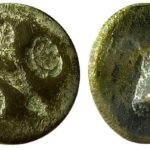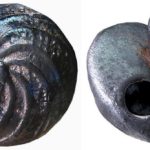What is the button‘s history? What was it made from? What was its use?

First language for the word button to appear was the French, bouton, or bouten to push.
Let’s take a look into the past and find out!! We may find something interesting that we never knew about!
Buttons are found to be used in its early stages as just ornaments, decorations on clothing or as seals, rather than its use of today. It didn’t start out as something used to hold a garment or a bag closed.
Buttons were found during the Kot Yaman phase, in the Indus Valley Civilization. (Somewhere between circa 2800-2600BCE), and in China during the Bronze Age (circa 2000-1500BCE), as well as in Ancient Rome.

Some of the buttons that were found were approximately 5000 years old!!! They were made of smooth, curved shell and had holes in to attach to clothing with thread. Some were even carved in different geometric shapes.
The first finding of a functional button was in a Hungarian tomb of conquering tribes late into the 9th century. In the 13th century buttons with buttonholes on garments to hold them closed, were first found in Germany. They became popular on snug-fitting clothing in Europe between the 13th and 14th century.
Buttons have been made from all kinds of materials, whether its synthetic or natural. There’s plastic buttons, seashell buttons, metal buttons, ceramic buttons, etc. The materials that the button was made from told its timeline of technology.
Those who were considered rich during the 1300-1400’s, went crazy over the buttons!! They had so many buttons on their garments that it took a long time to dress!! Try to picture yourself dressing with 100 buttons with 100 buttonholes to close!! Sorry, not for me.
Moving on into the timeline to the 1500’s, you’ll find that the King of England, Henry VIII, had a meeting with the King of France, Francis I, and both arrived with over 13,600 buttons!!! Now that is a little overboard, right?

And so the button craze continued until about the 16th century, when the Puritans declared it as sinful, the people became sensible about it and toned down the number of buttons required for fashion. So, with that as a requirement, button makers had to come up with elaborate pieces. Buttons made from gold, ivory, etc. It became a work of art.
Now we come to the 1600’s where we hear there is a report that the Duke of Buckingham wore a suit and cloak decked with diamond buttons!!! Can you say WOW?! Not very many people could even afford such a display! The Duke really showed his status. For the most part, the commoners used ceramic, silver and silk buttons. You can even find hand-painted buttons with scenery and other paintings.
When the 17th century rolled around, thread and embroidered buttons were introduced. The French army uniforms used the thread buttons, simple little balls of thread. But the button makers didn’t appreciate this and thus the government passed a law that forbade their use. Anyone found using them was fined!
Also during this era, steel buttons were beginning to be used on men’s garments. And by the end of the century, you saw bigger and bigger and bigger sized buttons!!
And now we come to the 18th – 19th century, where metal buttons were introduced by Abel Porter in 1802. He established a company in the Northeastern part of the U.S. He took advantage to become a big business, as imported metal buttons were not only expensive, but scarce.
So many challenges came with this endeavor, but Abel solved past problems by creating the button with a brass loop cast on the back. We can still see some of them today with the Scovill Manufacturing Co symbol stamped on the back.
Today, there are thousands and thousands of different buttons!!! Lots of different colors, shapes, sizes, etc!!!
